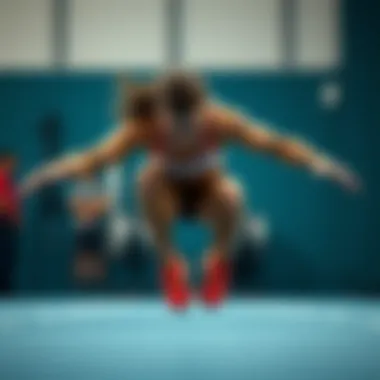Mastering Parallette Dips: Techniques and Benefits


Intro
In the realm of bodyweight training, parallette dips stand out as a powerful tool for enhancing strength, flexibility, and stability. This exercise, typically performed on small parallel bars, has garnered attention for its ability to engage multiple muscle groups effectively. It’s not just about upper body strength; the core and lower body are also engaged, facilitating a holistic workout that can adapt to various fitness levels.
The beauty of parallette dips lies in their versatility. Whether you're an avid gym-goer or someone just starting on their fitness journey, this exercise can be tailored to suit your needs. By understanding the technique, benefits, and variations, individuals can tailor their routines for maximum effectiveness. The journey into mastering parallette dips can open new doors in fitness, igniting growth in both physical and mental performance.
Key Benefits
Physical Health Benefits
Engaging in parallette dips brings a wealth of advantages that contribute to both immediate and long-term health gains. Here are some key enhancements to physical health:
- Upper Body Strength: Parallette dips primarily target the triceps, shoulders, and chest, leading to improved strength and tone in these muscle groups.
- Core Stability: Performing dips requires significant core engagement, thereby enhancing stability and control during movement.
- Functional Fitness: The movement patterns developed through parallette dips can translate into better performance in everyday activities and other physical exercises.
- Flexibility and Mobility: Regular practice can improve shoulder mobility and flexibility, crucial for overall movement efficiency.
Mental Well-being Enhancements
The psychological benefits of engaging in this form of training can be profound. Parallette dips do more than build muscle; they can also foster a stronger mindset:
- Focus and Concentration: Executing the dips requires attention to form and technique, promoting mental clarity and focus.
- Stress Relief: Physical activity serves as a natural stress reliever, and the release of endorphins during dips can improve overall mood.
- Confidence Boost: Overcoming the challenges posed by parallette dips can lead to a significant increase in self-confidence, empowering individuals to tackle other fitness goals.
Regularly incorporating parallette dips can enhance your overall fitness portfolio, offering both body strength and mental fortitude.
Practical Tips
Effective Meal Planning
Incorporating parallette dips into your routine can be complemented with proper nutrition. Here’s how to plan meals effectively to support your training:
- Protein-rich Foods: Include lean meats, legumes, and dairy to aid muscle recovery and growth.
- Complex Carbohydrates: Whole grains and vegetables provide sustained energy for workouts.
- Hydration: Keep hydrated to optimize performance and recovery.
Quick and Efficient Workouts
For those with busy schedules, here are some tips to fit parallette dips into your routine efficiently:
- Set Short Timeframes: Dedicate 15-20 minutes for a focused workout on dips, integrating them into your daily routine.
- Combine with Other Exercises: Pair dips with exercises like push-ups or planks to create a full-body workout in less time.
- Utilize High-Intensity Intervals: Incorporating dips into an interval training approach can enhance strength and burn calories efficiently.
By understanding the nuances of parallette dips, practitioners can elevate their fitness journey significantly. As you begin or continue to engage with this practice, remember to maintain a mindful approach towards your technique and wellness.
Prolusion to Parallette Dips
Parallette dips; they may seem just another fitness trend, but they pack a powerful punch regarding strength training and body control. As a unique exercise that uses two parallel bars, parallette dips not only challenge our upper body strength but also improve stability and coordination. From competitive athletes to casual fitness enthusiasts, the effectiveness of parallette dips is undeniable. This section will lay the groundwork for understanding why they deserve a spot in your workout routine, addressing key techniques and benefits that come along with this exercise.
Definition of Parallette Dips
Parallette dips are a form of bodyweight exercise performed between two parallel bars. Essentially, they involve lowering the body down in a controlled manner while maintaining support with the hands on the bars. As the elbows bend, it results in a full upper-body motion that integrates the shoulders, triceps, and chest. The beauty of this exercise lies in its simplicity and versatility. They can be performed in various setups, making them accessible to both novices and seasoned athletes alike.
Historical Context
The origins of parallette dips can be traced back to gymnastic training, where props like the parallel bars were utilized for building strength and mastering skills. Athletes in disciplines such as gymnastics and calisthenics began embracing these bars not merely for performance but as an integral part of their training regimen. Over time, the popularity of parallette dips extended beyond gymnastics, becoming a staple in functional fitness and bodyweight training circles. In the past decade, social media platforms like Instagram and YouTube have played a role in popularizing the exercise, showcasing impressive displays of skill and strength. Today, parallette dips are not only respected as an exercise enhances strength but also as a key component for those looking to master advanced movements in calisthenics.
Understanding the Mechanics
Understanding the mechanics behind parallette dips is crucial for anyone aiming to incorporate this powerful exercise into their routine. The nuances of body dynamics during dips can markedly impact performance, effectiveness, and overall safety. Having that knowledge allows practitioners to dismantle their technique and refine it, focusing on strength building while minimizing the risk of injury.
Body Dynamics During Dips
When executing parallette dips, the entire body engages in a concerted effort to maintain balance and power. The grip must be firm, and the feet keep a strategic position to provide stability. It's not simply a push downward; rather, think of it as a delicate dance of physics and muscle endurance. Moderate lean forward activates the shoulder muscles but too much can lead to strain.
Alignment of the spine plays a significant role, with a neutral position being essential. If the pelvis is not tucked correctly, it could cause an arched back or improper shoulder engagement. The weight shifts during the execution must be fluid, ensuring that lower body movements do not compromise upper body form. What becomes clear is that every little adjustment can make a world of difference in both performance and safety.
Muscle Groups Engaged
The beauty of parallette dips lies in their capability to engage multiple muscle groups simultaneously. This compound exercise primarily targets the triceps, shoulders, and core muscles, offering a comprehensive workout that builds functional strength.
Triceps
Strengthening the triceps is key to mastering parallette dips. These muscles are significant players in controlling the descent and ascent phases of the dip. They give the necessary push while stabilizing the elbows, making them vital for maintaining control throughout the motion.
The key characteristic of the triceps is their endurance capacity. Since dips often require multiple repetitions, a well-developed tricep can contribute greatly to the overall success of the exercise. However, while they are beneficial, poorly developed triceps might struggle, leading to compromised form or injury. Therefore, consistent attention to this muscle group can yield enormous benefits in both aesthetics and functionality.
Shoulders


Dips heavily involve the shoulder complex, which includes the deltoids and rotator cuff muscles, promoting stability and control. Engaging the shoulders not only assists in lifting the body but also helps in body balancing during the movement.
The unique feature of the shoulders in this context is their versatility. They can either be a strong asset or a weak link in executing parallette dips. Neglecting shoulder preparation—such as mobility exercises—can lead to strain and a decrease in effectiveness. Thus, their comprehensive strengthening can uplift overall performance in dips and other upper body movements.
Core Muscles
Many may underestimate the role of core muscles during dips. These muscles aren't just about aesthetics; they are the foundation of balance and control in almost any athletic movement. Incorporating core engagement when performing dips stabilizes the entire body, ensuring that dips are more effective and safe.
The key characteristic of core muscles is their function in maintaining posture. Proper engagement allows one to keep a straight body line rather than slouching or arching, leading to a more effective dip. Their unique advantage is the stabilization they provide; stronger core strength not only enhances performance but greatly reduces the risk of injury, highlighting their importance in mastering parallette dips.
Engaging all major muscle groups during parallette dips opens pathways to greater strength and balanced fitness, making them a vital addition to any workout regime.
In summary, mastering the mechanics of parallette dips hinges on understanding how body dynamics and muscle engagement work together. Awareness of form, alignment, and the intricate roles of various muscle groups creates a solid foundation for effective and safe workout practices.
Technique Fundamentals
When it comes to parallette dips, there’s much more than meets the eye. The technique lays the groundwork for success, acting like a well-tuned engine for a high-performance vehicle. Cultivating proper technique not only maximizes the effectiveness of each dip but also minimizes the risk of injury. Getting these fundamentals right ensures the practitioner gets the most out of this challenging exercise.
One particular aspect, body alignment, is crucial. When the body is properly aligned, it facilitates seamless movement. Meanwhile, step-by-step execution guides the user through each phase, ensuring that every motion is purposeful and effective. Finally, being aware of common mistakes can keep progress on track and prevent setbacks.
Proper Body Alignment
Proper body alignment is the backbone of effective parallette dips. When your body is correctly aligned, it allows for optimal muscle activation and reduces unnecessary strain. Think of alignment as the delicate balance between maintaining a straight line from head to heel while keeping your shoulders engaged and your core activated. This positioning increases the efficiency of the exercise and promotes higher levels of strength gains.
One key characteristic of proper alignment is maintaining straight elbows when lowering the body. If the elbows are bent, it may compromise the dip, limiting the activation of critical muscle groups and leading to a less effective workout. Proper alignment is a no-brainer for anyone aiming for true strength and stability. But if you forget this crucial point, you might end up not only wasting time but also risking injury.
Step-by-Step Execution
The execution of parallette dips breaks down into three phases: the starting position, the descending phase, and the ascending phase. Each phase is like a note in a symphony, contributing to a harmonious workout experience.
Starting Position
Starting position is where the magic begins. With your hands placed securely on the parallette bars, you need to position your body correctly for optimal results. A critical feature of the starting position is ensuring that your arms extend fully while your shoulders are slightly elevated. This creates a stable platform that allows for controlled movement. Not only does the starting position set the tone for the entire exercise, but it also prepares the shoulders and wrists for the strain ahead. If not done right, it can cause unnecessary stress on the joints. But when executed correctly, it offers a strong foundation for what's to come.
Descending Phase
The descending phase of parallette dips is where the real work happens. As you lower your body, maintaining control is paramount. The key characteristic here is to ensure that your elbows smoothly track back while you lower your torso. A unique advantage of this phase is the ability to engage multiple muscle groups simultaneously, such as the triceps and shoulders. When this phase is mismanaged, though, it can lead to an insufficient range of motion, ultimately hindering your strength development.
Ascending Phase
Once you’ve reached the bottom of your dip, it's time to push upwards—this is the ascending phase. The focus should shift towards actively engaging your tricep muscles while bringing your body back to the starting position. A defining feature of this phase is how it heavily relies on core stability to avoid swinging or losing balance. A well-executed ascending phase not only boosts strength but also enhances overall stability and functional fitness, making it a vital part of the dip's execution.
Common Mistakes
Even seasoned practitioners can make mistakes during dips, which can significantly affect results. Here, attention to detail is key.
Insufficient Range of Motion
One common blunder is insufficient range of motion. This mistake occurs when individuals don’t fully descend during the dip. This not only limits muscle engagement but can also lead to a stagnant workout. Proper range of motion is a must; without it, you're merely going through the motions.
Incorrect Hand Placement
Another pitfall is incorrect hand placement. Many think they can just slap their hands on the bars and get to work. But the truth is, the distance between the hands dramatically affects form and balance. The ideal placement should allow for comfortable elbow bending without compromising shoulder integrity. Incorrect placement can lead to discomfort and can hinder overall performance.
Poor Core Engagement
Lastly, poor core engagement can throw everything off balance. If your core isn't activated, you're essentially leaving a vital piece of the puzzle out. It can lead to haphazard movements and even risk injury. Engaging the core stabilizes the body, ensuring your movements are strong and controlled.
In summary, mastering the fundamentals of technique not only enhances the effectiveness of parallette dips but also supports the overall fitness journey. Proper body alignment, step-by-step execution, and awareness of common mistakes are integral to integrating this exercise into any routine successfully.
Benefits of Incorporating Parallette Dips
In the realm of calisthenics, parallette dips stand out as a versatile exercise, reaping several physical advantages for practitioners from beginners to seasoned athletes. Understanding the benefits of incorporating parallette dips into a regular fitness regimen can empower fitness enthusiasts to make informed decisions about their training. By honing in on these key benefits, practitioners can enhance their overall fitness levels while also building a robust foundation for more complex movements.
Strength Development
One of the most immediate benefits of parallette dips is their capacity for strength development. Engaging major muscle groups including the triceps, shoulders, and chest, these dips provide a rigorous workout that promotes hypertrophy. During the exercise, the vertical orientation of the body forces muscles to engage differently compared to standard dips done on parallel bars. It challenges the upper body to adapt and strengthens numerous stabilizing muscles, ultimately fostering greater power in future lifts and movements.
A strong upper body is vital for various fitness activities, from push-ups to overhead presses. Enhanced strength from parallette dips translates well into everyday tasks and activities, making moving and lifting much easier.
"Strength is not just about lifting weights; it’s about functional strength throughout daily movements."
Improved Stability and Balance


Following the thread of strength, improved stability and balance can also be attributed to parallette dips. The exercise's requirement for maintaining core engagement encourages the body to stabilize while the arms power through the dip movement. As core muscles are activated, not only does one fortify their trunk muscles, but they also improve coordination and finesse in body control.
Achieving balance in dips necessitates using a range of stabilizers. This interplay betwwen primary muscle groups and the core results in a well-rounded skill set that's crucial in many sports as well as the fitness world. Over time, practitioners will likely notice enhanced overall stability, particularly during dynamic movements or transitions, which is essential for preventing injuries and maintaining a well-rounded fitness profile.
Enhanced Functional Fitness
Lastly, incorporating parallette dips contributes to enhanced functional fitness. This term speaks to the ability to perform real-life activities with greater ease and coordination. Dips mimic various pushing and lifting actions, qualtiies important in daily life, whether it be lifting groceries or playing sports.
With every dip performed, practitioners develop the strength and balance necessary to tackle functional movements efficiently, leading to an improved quality of life. By honing these skills, parallette dips create a bridge between strength training and functional mobility, making them an asset in any fitness program. Incorporating these dips into one’s routine not only builds muscle but also paves the way for achieving broader fitness goals and ensuring longevity in performance.
In brief, establishing a solid foundation of strength, stability, and functional capability cannot be overstated. Harnessing the benefits of parallette dips is a strategic decision for anyone serious about taking their fitness endeavors a notch higher.
Variations of Parallette Dips
Understanding the variations of parallette dips is essential for anyone looking to elevate their calisthenics game or strength training regimen. Each variation offers distinctive challenges and benefits, allowing individuals to target different muscle groups while enhancing their skills. When integrated properly into a workout routine, these variations not only contribute to overall strength development but also maintain engagement and motivation throughout the training process.
Artistic Dips
Artistic dips provide a unique twist on the traditional parallette dip. While the standard dip focuses strictly on strength and form, artistic dips incorporate elements of gymnastics and body control. This variation requires a substantial amount of balance, flexibility, and coordination, making it not just a muscle-builder but also a test of body awareness.
Practicing artistic dips often includes transitioning into different shapes and holds, challenging the upper body while engaging the core for stabilization. To perform this variation:
- Set your parallette bars securely on a flat surface, ensuring they won’t move during your workout.
- Start from the basic dip position, lowering your body straight down.
- As you ascend, engage your core and begin to transition to an artistic pose, like a tuck or straddle, for a brief duration.
- Repeat, focusing on controlled movement and body positioning.
Incorporating artistic dips can spice up a workout routine, keeping practice fresh and fostering a unique sense of achievement as one masters various shapes.
L-Sit Dips
L-sit dips combine an effective dip with the core-engaging L-sit position, making this variation a two-for-one deal. This exercise not only builds pressing strength but also challenges the abdominals and hip flexors.
To perform an L-sit dip, follow these steps:
- Begin in a seated position on the parallette bars, gripping tightly and keeping your legs extended fully to form the ‘L’ shape.
- Press down into the bars while lifting your body upwards, lowering down into a dip as you go.
- Maintain the L-sit position while descending and ascending, engaging your core throughout.
L-sit dips are particularly beneficial for improving functional strength and developing a solid foundation for more advanced calisthenics moves. Regular practice of this variation will undoubtedly boost overall core strength and stability.
Weighted Dips
Adding weight to your parallette dips can create an entirely new level of challenge. Weighted dips, whether using a weight vest or chain, provide an excellent method to progressively overload the muscles, ultimately leading to greater strength gains. Here’s how to execute weighted dips:
- Select your method of adding weight. You may wear a weighted vest or use a dip belt with plates.
- Assume the standard dip position secure in your grip, feet off the ground.
- As you lower yourself, maintain control, and focus on full range of motion.
- Push yourself back up, aiming for smooth movements for each repetition.
This increased load places additional stress on the triceps, shoulders, and chest, making it crucial to only attempt weighted dips once a solid understanding of form and control has been established.
Incorporating these variations into your training regimen can ensure not only well-rounded upper body development but also an exciting and challenging path toward achieving fitness goals. By keeping workouts diverse, one can avoid plateaus and continually progress.
Integrating Parallette Dips into Workouts
Incorporating parallette dips into workouts isn't merely about executing a set of repetitions; it’s a strategic endeavor to elevate strength and athletic performance. These dips can be a cornerstone in your workout regime, influencing everything from muscle development to endurance. Understanding how to effectively integrate this exercise will not only maximize its advantages but also enhance your overall fitness journey.
Creating a Balanced Routine
Crafting a balanced workout schedule that incorporates parallette dips hinges on understanding your own body dynamics and fitness objectives. Not every individual will need a regimen that focuses heavily on shoulder and tricep strength, yet those muscles are vital in many complex movements. Thus, aiming for symmetry in muscle engagement can ensure comprehensive development.
Consider coupling parallette dips with push-ups, pulls-ups, and core exercises to create a holistic plan. This alliance ensures that opposing muscle groups are engaged, fostering improved stability and injury prevention. A thoughtful approach means more than just seamlessly adding dips; deliberate programming provides the groundwork for progressive overload, which is essential for strength gains. Crafting a structured plan not only promotes better results but also nurtures long-term commitment to your workout routine.
Sample Workout Plans
Integrating parallette dips can take various forms depending on the fitness level. Let’s break this down into three distinct levels, revealing how each can be beneficial.
Beginner Level
At the beginner level, the focus is on establishing a solid foundation. This stage often draws attention to fundamental movements and body awareness. Parallette dips at this stage might be performed with a reduced range of motion or from the knees.
The primary characteristic of this approach is accessibility. By making the exercise approachable, individuals are less likely to experience injury and more likely to build confidence. A unique feature here could include focusing on body positioning and grip, which is crucial before moving onto more advanced techniques.
Advantages of this level are significant; practitioners learn control and stability, laying the groundwork for deeper strength integration in later stages.
Intermediate Level
Once the foundation is laid, the intermediate level offers a chance to explore increased complexity and strength. Here, parallette dips can evolve into more dynamic movements, including slow eccentrics or incorporating slight rotations.
The standout trait of this level is progressive challenge. By adding variations or manipulating tempo, individuals can maximize muscle engagement. This transition encourages enhanced coordination alongside muscle growth.


One notable consideration at this level is ensuring that form remains paramount. With the additional complexity, the risk of poor mechanics increases, making proper execution essential.
Advanced Level
At the advanced stage, parallette dips can transcend just strength building; they become a tool for mastering body control and explosiveness. Advanced practitioners may indulge in one-arm dips or incorporate other skills, like L-sits or transitions into a planche.
The hallmark of this stage is skill mastery and exploration. Here, the dips are no longer just an exercise but a conduit for deeper capabilities. The ability to perform these dips fluidly opens avenues to more complex calisthenics and movement patterns.
Advantages include the potential for noticeable improvements in upper body strength and stability. However, the downside often lies in the increased demand placed on joints and tendons, which necessitates cautious progression to avoid strain or injury. Thus, pursuing versatility while maintaining safety is critical for anyone engaging in this level.
Integrating parallette dips into workouts can be extremely advantageous when done thoughtfully. By creating a well-rounded routine and acknowledging specific fitness levels, individuals can harness the full power of this exercise while promoting growth and resilience in their fitness paths.
Safety Considerations
When integrating parallette dips into your workout routine, keeping an eye on safety is paramount. Ignoring safety measures can lead to unnecessary injuries, which only hinders progress. This section elaborates on the safety considerations necessary for anyone engaging in this demanding yet rewarding exercise.
Individual Fitness Levels
Understanding your own fitness level is crucial before diving headlong into parallette dips. Everyone comes to the table with different skills, strengths, and weaknesses. Some may have years of experience with calisthenics, while others may be just starting their fitness journey.
- Assess Your Strength: If you're new to strength training, attempting parallette dips may be ambitious. Gauge your general strength, particularly in the triceps and shoulders, before attempting this exercise.
- Listening to Your Body: Pay attention to how your body feels, especially any signs of fatigue or discomfort. A good rule of thumb is to stick to movements that feel within reach, gradually increasing complexity and difficulty.
- Progression Safety: If you're not ready for full dips, consider starting with easier variations. Choose from exercises like incline push-ups, then transition steadily to dips once you're confident.
Proper Warm-Up Techniques
Warming up serves as the first line of defense against injuries. Think of it as priming your muscles for action. Here’s how to effectively warm up before practicing parallette dips:
- Dynamic Stretching: Begin with dynamic stretches that engage the shoulders, wrists, and triceps. Arm circles and torso twists activate your upper body, preparing it for motion.
- Mobility Exercises: Incorporate movements that promote joint mobility. For instance, wrist rotations and shoulder rolls can improve flexibility and help prevent strains.
- Gradual Load Increase: Start with light exercises like scapular push-ups to activate the shoulder muscles. These exercises help in easing into your workouts without risking injury.
Signs of Strain or Injury
Recognizing early signs of strain or potential injury can make all the difference in maintaining a long-term fitness journey. Here are key indicators to watch for:
- Discomfort in Joints or Muscles: A dull ache may signal that something is off. It is crucial to differentiate between muscle fatigue and painful sensations.
- Sudden Pain: If you feel any sharp or unusual pain while executing dips, it's wise to stop immediately. Ignoring such signals can lead to serious injuries.
- Limitations in Mobility: If you find it difficult to perform a dip due to unusual stiffness or lack of control, take this as a red flag.
Always prioritize your well-being over performance and aesthetics. Safety should lead your decisions in training.
By understanding these safety considerations, you create a personalized and secure environment for incorporating parallette dips into your regimen. Prioritizing safety not only enhances your workout experience but also sets you on a clear path toward achieving your fitness goals effectively.
The Role of Parallette Dips in Calisthenics
Parallette dips serve as a cornerstone in the landscape of calisthenics, a discipline emphasizing bodyweight exercises that foster strength, flexibility, and coordination. Understanding their significance requires a closer examination of how these exercises catalyze progression and contribute to the mastery of various skills. Integrating parallette dips into one's routine can yield a multitude of benefits, from enhancing muscle engagement to refining overall body control.
Importance in Progression
Progressing through calisthenics often revolves around mastering fundamental movements. Parallette dips are a prime example of an exercise that not only builds foundational strength but also conditions the body for more advanced maneuvers. By focusing on the various phases of the dip—namely, the descent and ascent—practitioners enhance their capacity to control their body, a skill that forms the basis for more complex exercises.
Moreover, these dips act as a bridge to other advanced techniques. When performed consistently, they help to establish the necessary muscle strength in the shoulders, triceps, and core, assisting in the progression to movements like handstand push-ups or planche holds. In essence, parallette dips serve not just as a stand-alone exercise, but as a vital stepping stone in the continuum of calisthenics.
Contribution to Skill Mastery
Skill mastery in calisthenics isn’t merely about strength—it's about the finesse of movement, balance, and precision. Parallette dips challenge the body to maintain stability while executing the task at hand.
Through regular practice, athletes build a robust proprioceptive awareness, meaning they enhance their ability to sense where their body is in space. This awareness is critical when transitioning to more difficult skills, as it directly relates to balancing and controlling one's body weight. For instance, when striving for a handstand, the ability to engage and stabilize muscles developed through parallette dips can make all the difference.
In summary, parallette dips hold a significant place in the realm of calisthenics. They not only facilitate progression toward advanced skills but also refine the practitioner’s overall movement quality. With every dip, there is an opportunity to strengthen not just muscles, but also the very essence of body control and agility vital for almost any calisthenics endeavor.
Future Trends in Dipping Exercises
The world of fitness is constantly evolving, and parallette dips are no exception. As enthusiasts and professionals continue to explore new ways to optimize performance and enhance strength training, understanding future trends related to parallette dips is essential. These trends not only keep the practice fresh but also offer insights into enhancing effectiveness and safety. Let's examine the innovations in equipment design and emerging training techniques shaping the future of dipping exercises.
Innovations in Equipment Design
Equipment design plays a notable role in how efficiently bodyweight exercises can be performed. One trend gaining traction is the development of adjustable parallette bars, allowing users to modify the height and width according to their comfort and training needs. This customization can accommodate various body types and skill levels, making dips more accessible and tailored.
Currently, many parallette sets incorporate features like anti-slip grip surfaces and lightweight materials that enhance stability without compromising portability. These new designs mean that whether someone is training at home or in a gym, they can ensure a safer workout environment. For example:
- Durable Materials: High-grade metals like aluminum are becoming the norm, increasing longevity while reducing weight.
- Added Functionality: Some designs integrate resistance bands, providing additional challenges and engagement for the muscles during the dips.
This evolution not only enhances performance but also encourages users to push their boundaries without fear of injury. As manufacturers recognize the diverse needs of athletes, we can expect further innovation aimed at improving user experience.
Emerging Training Techniques
Training techniques are also adapting to the shift in fitness paradigms. One method that is gaining popularity is the integrative approach, which emphasizes combining parallette dips with other exercises to create a holistic workout. This technique promotes comprehensive muscle engagement and functional strength development.
Moreover, there is an increasing focus on the role of body mechanics in dip training. Incorporating training sessions that analyze the movement patterns of dips using technology, such as motion capture systems, can help athletes understand their form better and make necessary adjustments for optimal execution.
In addition, here are some emerging trends to keep an eye out for:
- High-Intensity Interval Training (HIIT): Integrating parallette dips into HIIT routines is quickly becoming popular, as it maximizes calorie burn while building strength—perfect for those pressed for time.
- Functional Training: Many coaches are now emphasizing functional strength. Parallette dips, when combined with movements like push-ups and core exercises, can prepare the body for everyday physical activities, promoting mobility.















